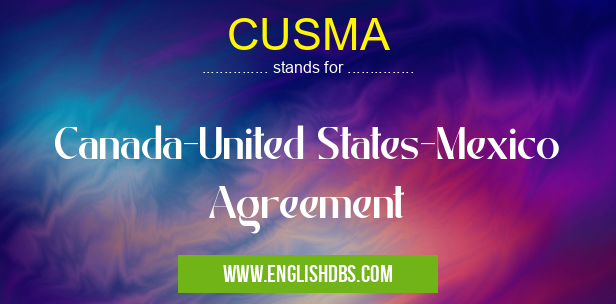What does CUSMA mean in CANADIAN
CUSMA stands for Canada-United States-Mexico Agreement, formerly known as NAFTA (North American Free Trade Agreement). It is a trilateral trade agreement between Canada, the United States, and Mexico. The agreement was signed on November 30, 2018, and came into effect on July 1, 2020, replacing NAFTA.

CUSMA meaning in Canadian in Regional
CUSMA mostly used in an acronym Canadian in Category Regional that means Canada-United States-Mexico Agreement
Shorthand: CUSMA,
Full Form: Canada-United States-Mexico Agreement
For more information of "Canada-United States-Mexico Agreement", see the section below.
Key Features of CUSMA
- Elimination of Tariffs: CUSMA eliminates tariffs on most goods traded between the three countries.
- Rules of Origin: CUSMA establishes specific rules of origin that determine whether a product qualifies for preferential treatment under the agreement.
- Labor Standards: CUSMA includes provisions to protect labor rights and promote good working conditions in all three countries.
- Intellectual Property: CUSMA strengthens protections for intellectual property, such as patents, trademarks, and copyrights.
- Dispute Resolution: CUSMA establishes a mechanism for resolving disputes between the parties.
Benefits of CUSMA
- Increased Trade and Investment: CUSMA is expected to increase trade and investment flows between Canada, the United States, and Mexico.
- Job Creation: The agreement is estimated to create new jobs in all three countries.
- Economic Growth: CUSMA is expected to boost economic growth in all three countries by providing businesses with greater access to markets and reducing costs.
- Harmonized Regulations: CUSMA aims to harmonize regulations across the three countries, making it easier for businesses to operate.
- Enhanced Border Security: CUSMA includes provisions to enhance border security and facilitate the movement of goods and people.
Essential Questions and Answers on Canada-United States-Mexico Agreement in "REGIONAL»CANANDAPROVINCES"
What is CUSMA?
CUSMA (Canada-United States-Mexico Agreement) is a free trade agreement between Canada, the United States, and Mexico. It replaced the North American Free Trade Agreement (NAFTA) on July 1, 2020.
What are the key changes in CUSMA compared to NAFTA?
CUSMA includes several key changes, including:
- Stronger labor and environmental provisions
- Updated rules for intellectual property
- New provisions on digital trade and e-commerce
- Streamlined customs procedures
How does CUSMA benefit businesses?
CUSMA benefits businesses by:
- Reducing tariffs and other trade barriers
- Creating a more predictable and stable trading environment
- Facilitating cross-border investment
- Promoting innovation and economic growth
How does CUSMA affect consumers?
CUSMA benefits consumers by:
- Lowering prices on goods and services
- Increasing the variety of products available
- Improving access to high-quality goods from all three countries
What are the challenges associated with implementing CUSMA?
Some of the challenges associated with implementing CUSMA include:
- The need to make changes to domestic laws and regulations
- The potential for increased costs for businesses
- The need to address concerns about labor and environmental standards
What is the future of CUSMA?
CUSMA is expected to have a positive impact on the economies of Canada, the United States, and Mexico. It is a modern and comprehensive trade agreement that will help to promote trade, investment, and economic growth in North America.
Final Words: CUSMA is a comprehensive trade agreement that aims to deepen economic integration between Canada, the United States, and Mexico. The agreement is expected to provide numerous benefits, including increased trade and investment, job creation, economic growth, harmonized regulations, and enhanced border security.
